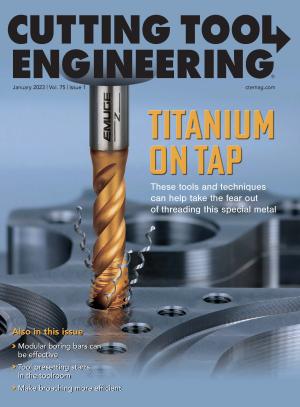If you make steel tools like I do, sometimes a hard surface is in order. There is a way to case-harden steel that is inexpensive and quick and can be done with an acetylene torch as the heat source. It uses a powder called Cherry Red that is available from tool supply houses.
I use a heat-treating company to do the work if the part requires a certain depth of the case and hardness. For example, I get parts that require a case 0.003" to 0.005" thick and 62 HRC. I would not try to do that with the Cherry Red process, but if I make a tool or die for in-house use and want a case with an HRC above 55, then I’ll use it.
The heat treater that I use has a lot charge of $150. If I want a case on the end of a punch that is 0.75" dia., I can do that with my acetylene torch for about $5 of material and 10 minutes of time. I like those numbers.
The process is simple.
1. Heat the area to be heat-treated to a cherry red color.
2. Coat the red area with the heat-treating compound. When I do the end of a punch, I put some compound in a tin can and plunge the tool in. Use a well-ventilated area or, better yet, do it outdoors because it gives off ammonia fumes when the compound is heated. Cherry Red comes in a plastic container, so don’t put hot metal in the container. And take care because the compound can irritate skin.
3. Reheat the area to be hardened to the cherry red color.
4. Quench the part in water or oil, and let cool.
5. Soak the part in water to remove the compound from the part.
The process causes a layer of the compound to become stuck on the steel, but it is water-soluble and so not too hard to remove. The compound dissolved in water is alkali and can irritate skin, so it’s a good idea to use rubber gloves and flush with plenty of water.
The picture on Page 10 shows what is needed: a container of Cherry Red; two tin cans — one to hold the compound and one for the quench; pliers to grab your part; and a spoon to coat the part if that’s appropriate. You also need an acetylene torch. Plan your process beforehand, and check to see that everything will work smoothly. You want the part to be bright red when coated by the hardening compound. You’ll be dealing with hot stuff, so having a plan is worthwhile.
Years ago, there were compounds to do this that had cyanide in the mix. You sure don’t want that. Cherry Red has no cyanide, but you don’t want to eat the stuff or get it in your eyes. Like every process at a metalworking shop, you have to be reasonable about safety.
That’s it. Quick, cheap and easy. And as hard as the back of Superman’s head.
Related Glossary Terms
- hardening
hardening
Process of increasing the surface hardness of a part. It is accomplished by heating a piece of steel to a temperature within or above its critical range and then cooling (or quenching) it rapidly. In any heat-treatment operation, the rate of heating is important. Heat flows from the exterior to the interior of steel at a definite rate. If the steel is heated too quickly, the outside becomes hotter than the inside and the desired uniform structure cannot be obtained. If a piece is irregular in shape, a slow heating rate is essential to prevent warping and cracking. The heavier the section, the longer the heating time must be to achieve uniform results. Even after the correct temperature has been reached, the piece should be held at the temperature for a sufficient period of time to permit its thickest section to attain a uniform temperature. See workhardening.
- hardness
hardness
Hardness is a measure of the resistance of a material to surface indentation or abrasion. There is no absolute scale for hardness. In order to express hardness quantitatively, each type of test has its own scale, which defines hardness. Indentation hardness obtained through static methods is measured by Brinell, Rockwell, Vickers and Knoop tests. Hardness without indentation is measured by a dynamic method, known as the Scleroscope test.
- heat-treating
heat-treating
Process that combines controlled heating and cooling of metals or alloys in their solid state to derive desired properties. Heat-treatment can be applied to a variety of commercially used metals, including iron, steel, aluminum and copper.
- lapping compound( powder)
lapping compound( powder)
Light, abrasive material used for finishing a surface.
- metalworking
metalworking
Any manufacturing process in which metal is processed or machined such that the workpiece is given a new shape. Broadly defined, the term includes processes such as design and layout, heat-treating, material handling and inspection.
- titanium nitride ( TiN)
titanium nitride ( TiN)
Added to titanium-carbide tooling to permit machining of hard metals at high speeds. Also used as a tool coating. See coated tools.


